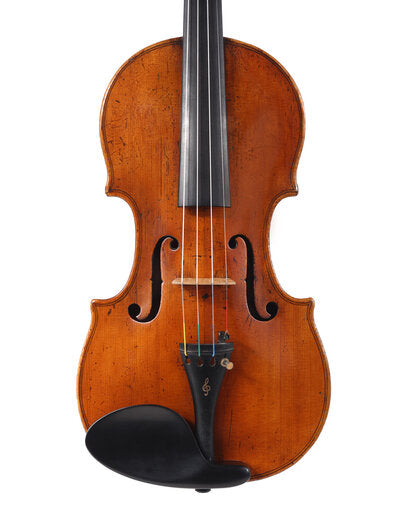When to Rent and When to Purchase Fractional Violins: A Complete Guide for Parents
Share
Deciding whether to rent or purchase a fractional violin represents one of the most common dilemmas facing parents of young musicians. With children growing rapidly and progressing through multiple violin sizes, the financial and practical considerations can feel overwhelming. Understanding when renting makes sense versus when purchasing becomes the better investment will help you make informed decisions that support your child's musical journey without breaking the budget.
Understanding the Fractional Violin Journey

Before diving into rental versus purchase decisions, it's essential to understand the typical progression through fractional violin sizes. Most young violinists begin their journey with 1/16 size or 1/32 size violins as early as age 3-4, eventually graduating through 1/10, 1/8, 1/4, 1/2, 3/4, and possibly 7/8 size before reaching full size.
This progression typically spans 6-10 years, with each size lasting anywhere from 6 months to 2 years depending on the child's growth rate and age when starting. Understanding this timeline helps parents anticipate the investment required and plan accordingly.
When Renting Makes Perfect Sense
Rapid Growth Periods
Renting fractional violins becomes the obvious choice during periods of rapid physical development. Children between ages 3-8 often outgrow violin sizes within 6-12 months, making rental programs incredibly cost-effective. The smallest sizes, including 1/32, 1/16, and 1/10 size violins, are prime candidates for rental since children typically use them for the shortest periods.
Testing Musical Commitment
For families uncertain about their child's long-term interest in violin, rental programs provide a low-risk way to explore musical education. Rather than investing hundreds or thousands of dollars upfront, rental allows parents to gauge their child's enthusiasm and commitment before making substantial financial commitments.
Budget Constraints
Rental programs typically require minimal upfront investment, often just the first month's rental fee plus a small security deposit. This accessibility makes quality instruments available to families who might otherwise struggle to afford violin lessons and instruments simultaneously.
Maintenance Convenience
Rental agreements usually include basic maintenance, repairs, and insurance coverage. For busy parents juggling multiple responsibilities, this convenience factor eliminates worries about instrument care, damage, or theft.
Flexibility During Uncertain Times
Life circumstances can change unexpectedly. Rental agreements provide flexibility to pause or discontinue without the commitment of ownership, making them ideal during periods of potential relocation, financial uncertainty, or changing family priorities.
When Purchasing Becomes the Better Investment

Stabilized Growth Patterns
Once children reach ages 9-12, growth patterns often stabilize somewhat, and they may use the same violin size for 18-24 months or longer. At this point, purchasing 3/4 size or 7/8 size violins begins making financial sense, especially when quality instruments can be resold to recoup some investment.
Serious Musical Commitment
Students demonstrating serious musical dedication, participating in youth orchestras, or preparing for competitions benefit from owning their instruments. Consistent practice on the same violin allows for deeper musical connection and familiarity that enhances performance quality.
Long-Term Cost Analysis
When rental costs over 18-24 months approach or exceed the purchase price of a quality fractional violin, buying becomes more economical. This calculation becomes particularly relevant for larger fractional sizes like 1/2 and 3/4 size violins that students use for extended periods.
Instrument Quality Preferences
Rental fleets typically consist of entry-level instruments designed for durability rather than exceptional sound quality. Families prioritizing superior tone and playability may prefer purchasing higher-quality fractional violins that enhance the learning experience and musical development.
Resale Value Considerations
Quality fractional violins from reputable makers retain value reasonably well, especially in larger sizes. Parents can often recoup 50-70% of their investment when selling well-maintained instruments, making purchase costs more palatable.
Making the Transition: Hybrid Approaches

Many families find success combining rental and purchase strategies throughout their child's fractional violin journey. Common approaches include renting the smallest sizes (1/32, 1/16, 1/10, and 1/8) while purchasing larger sizes (1/4, 1/2, 3/4) when commitment becomes clear.
Financial Planning Strategies
Rent-to-Own Programs
Many violin shops offer rent-to-own programs allowing rental payments to apply toward eventual purchase. These programs provide flexibility while building equity in an instrument, making them particularly attractive for families uncertain about timing.
Trade-In Programs
Some retailers offer trade-in programs allowing families to apply the value of outgrown instruments toward larger sizes. This approach reduces the financial burden of frequent size changes while ensuring children always have properly sized instruments.
Seasonal Considerations
Violin rental and purchase prices often fluctuate seasonally, with best deals typically available during summer months when demand decreases. Planning ahead can result in significant savings on both rental fees and purchase prices.
Quality Considerations Across All Options
Regardless of whether you choose to rent or purchase, instrument quality remains paramount for proper musical development. As discussed in our guide on "How the Right Size Violin Sets the Foundation for Proper Technique," properly sized, well-maintained instruments are essential for developing correct playing habits and preventing injury.
The sound quality differences between rental and purchased instruments, explored in detail in "The Sound Difference," can significantly impact a student's musical experience and motivation to continue playing.
Making Your Decision
The rent versus buy decision ultimately depends on your family's specific circumstances, including your child's age, growth rate, musical commitment level, budget constraints, and long-term goals. Consider these factors carefully, and don't hesitate to consult with violin teachers, shop professionals, and other parents who have navigated similar decisions.
Remember that there's no universally correct answer – the best choice is the one that supports your child's musical development while fitting comfortably within your family's financial and practical constraints. Whether you choose to rent, buy, or combine both approaches, the most important factor is ensuring your young musician has access to a properly sized, quality instrument that encourages their musical growth.
For expert guidance on selecting the right fractional violin size and rental or purchase options, explore our complete collection of undersize violins and speak with our knowledgeable staff about the best approach for your family's unique situation.

